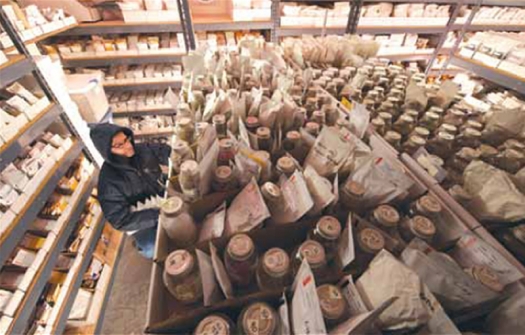Seed Savers Exchange safeguards diversity
seedsaversexchangeiowa.jpg

Photo courtesy of Seed Savers Exchange
Seed Savers Exchange currently has more than 20,000 seed varieties stored in an underground freezer vault in Iowa.
In the 1930s less than 1 percent of farmers were growing produce from hybrid seeds. By 1995, however, over 90 percent of commercially grown produce were hybrid varieties. The Seed Savers Exchange in Iowa is working to reverse that trend by collecting, storing and distributing seeds for about 26,000 varieties of vegetables, fruits, flowers and other plants grown decades ago. The nonprofit's mission is to conserve America's culturally diverse but endangered food crop heritage for future generations.
Heirloom varieties are increasing in popularity as both home gardeners and commercial growers seek more flavorful produce, as well as crops that are best suited for particular regions and micro-climates. Growing heirloom crops and flowers has other advantages beyond taste and scent. Growers can collect the seeds from a crop and plant them the following seasons, unlike hybrid and patented varieties that must be purchased every year. More importantly, genetic diversity is critical to the nation's food supply and security. If all varieties of corn, for example, are grown from the same hybrid, a disease, climate change, or other hazard could wipe out the entire corn supply.
"We look at diversity as not just being what's popular today, but as a pallete, a menu, available for future gardeners and generations," said John Torgrimson, the executive director at Seed Savers Exchange. "Diversity is increasingly important. There may be a variety in our collection that may be in great demand in 100 years. Last year we had a drought here, and found there was a late tasseling corn that did really well," Torgrimson continued from his office just outside Decorah, Iowa. "That variety might be a variety that people and seed companies turn to in the future."
Diversity among food crops began declining as commercial growers proliferated and began shipping their produce to markets farther and farther away from their farms. Seeking consistent products that held up well during storage and shipping, farmers began turning to varieties that had been bred for the marketplace.
"The Red Delicious apples of today bear very little resemblance to the Red Delicious that were available in the 1800s," Torgrimson said. "In creating an apple that was able to be shipped long distances the taste was bred out of it."
Those practices also led to a decrease in diversity. Hundreds of years ago, there were more than 20,000 apple varieties grown. By the year 2000, Torgrimson says two-thirds of those varieties had been lost. Seed Savers Exchange works to prevent other varieties from disappearing by collecting and storing heirloom seeds at its seed bank.
Seed storage
The largest non-governmental seed bank in the nation, the exchange began with two seed varieties. Diane Ott Whealy and her then husband, Kent Whealy were preparing to plant their first garden together in the 1970s. Diane's grandfather Ott gave her some morning glory and tomato seeds to use.
Having grown up about five miles from her grandparents' Iowa farm, Diane was familiar with the morning glories and tomatoes grandfather Ott grew in his gardens. But she was surprised when he told her his father had brought the original seeds to the United States when he emigrated from Bavaria in the 1870s.
Around the time Diane planted her first crop of her family's heirloom morning glories and German Pink tomatoes, the seed industry was undergoing a huge change. Seed companies were consolidating and introducing more hybrid seed varieties at the expense of many of the old varieties.
"We were losing a lot of generic varieties, and we realized we were the stewards of the seeds," Diane recalls.
Seeking other seed stewards and likeminded gardeners, the couple put an ad in Mother Earth News in 1975 asking people who were growing and collecting heirloom varieties to contact them.
"People responded, sending us seeds, stories and encouragement," Diane said. "It was so encouraging that so many people were writing to us that we decided to start a network linking all these people and their seeds together."
They called the new network True Seed Exchange. Initially, the pair facilitated about 30 people who were interested in swapping seeds with each other. Diane and Kent collected the information from gardeners and compiled it in a directory of people who were willing to swap heritage seeds. Copies of the directory were duplicated and distributed via mail. Interest in seed swapping grew, and over the years the program expanded far beyond the Whealys' imagination. Renamed the Seed Savers Exchange in 1979, the organization now has about 13,000 members in the United States and 40 different countries.
The organization maintains meticulous records about the varieties it saves along with the stories behind them.
Currently, the nonprofit has well over 20,000 different seed varieties stored in an underground freezer vault in northeast Iowa. As a safeguard, it also stores backup samples in the USDA Seed Bank in Fort Collins, Colorado, and at Svalbard Global Seed Vault in Norway.
Properly preparing seeds for storage is critical. After the seeds are harvested, they are carefully dried, then packed in foil packets which are heat sealed before being placed in cold storage.
"Any moisture will start the seeds to either germinate or decrease in vitality," Steve Carlson, Seed Savers Exchange communications coordinator, explained. "Dry, dark and cool are the three main criteria for storage."
Heritage Farm
Some seed varieties can remain in storage for up to 20 years, while others remain viable only for a couple of years. Every year, germination tests are performed, and the organization plants about 500 heirloom varieties to grow out and harvest fresh seeds from at its Heritage Farm. The farm is located in Iowa's Winneshick County and encompasses 890 acres of land. Certified organic by the Iowa Department of Agriculture and Land Stewardship, the farm hosts more than 300 native species of plants, including seven that are threatened or endangered.
The heritage garden also contains a rich diversity of apple varieties. Before the commercial era, farmers grew different types of apples for different purposes, such as pressing for cider, baking, storing, making sauce or eating out of hand. The heritage apple orchard features over 550 different apple varieties, including old favorites like Fameuse, Minkler Molasses, the Knobbed Russet and the Swayzie. The latter was a highly popular, flavorful apple exported to the United Kingdom where it commanded exorbitant prices, Carlson said.
"The Swayzie looked like a potato and tasted like a blend of plums and apples," Carlson said. "It was the kiwi of its day."
The farm also includes display gardens. The farm is open to the public, drawing about 15,000 visitors each year. Visitors come to the farm to learn about heirloom seeds, and explore its hiking trails. Popular with outdoors enthusiasts, birdwatchers and naturalists as well as gardeners, the farm is a recreational and educational resource.
"Heritage Farm is a beautiful classroom," Ott Whealy said. "It's a really diverse environment."
The organization also contracts with other growers to increase its seed supplies, Carlson said. Seed production is needed to supply customers of the organization's for-profit branch.
"About 10 years ago we started a commercial catalog to get heirloom seeds out for general distribution," Carlson said. "The catalog reaches a much greater audience."
Each year, about 600 heirloom varieties are offered in the catalog, which is delivered to several hundred thousand people. The online and mail order sales help fund the nonprofit arm of Seed Savers Exchange, which previously relied on membership dues and grants. Catalog sales currently bring in enough money to cover more than half of the organization's operating costs and have allowed the exchange to further its mission.
"We've experienced such a huge growth since we introduced our commercial catalog," Carlson said. "Currently we have about 50 employees, which is well over twice what we had 10 years ago."
The growth has allowed the organization to increase its efforts to educate the public about food production and the importance of diversity in the crops.
Jeffrey Smith, the founding executive director of the Iowa-based Institute of Responsible Technology and a leading spokesperson on the health dangers of GMOs, says he is grateful for Seed Savers Exchange's help and support in alerting its customers about the dangers of eating genetically modified food crops.
"They are a group of folks dedicated to heirloom seeds and providing information about GMOs," said Smith. "It's great when the biotech industry is buying up the seeds and making natural seeds less available that organizations like Seed Savers Exchange is providing real seeds for real foods. (Heirloom) plants are an essential link for preserving the nature of nature."
Helping hands
An annual U.S. Seed Savers Exchange membership costs $40. In return, members receive several publications, including the annual Yearbook, which lists open-pollinated heirloom seed varieties available for exchange. The 2013 Yearbook has 694 listed members offering 12,495 unique varieties and a total of 19,888 listings. Those listings include 4,749 tomatoes, 875 peppers, 362 squash and 1,553 bean varieties. The current yearbook is as big as a city phonebook. Seed Savers Exchange expects to save paper, and make the yearbook more user-friendly by adding a new online seed exchange. The web version will allow people to easily search for specific characteristics, such as the best orange canning tomato for a specific part of the country. Donor members who provide seeds to other members are the heart and soul of Seed Savers Exchange, which sets the organization apart from other suppliers of heirloom seeds.
"We're unique in that we are definitely a participatory organization," said Carlson.
While the main focus has always been on the seed exchange, the organization also solicits open-pollinated heirloom seeds from its members to catalog and store. People send in heirloom seeds from all over the country, along with information about the variety and how they obtained them. In many cases, people share personal memories of seeing the flowers, vegetables or fruits growing in a relative's garden decades ago, much like Diane Ott Whealy recalls grandpa Ott's purple morning glories.
For more information, visit the Seed Savers Exchange.
Originally published in Acres, U.S.A., January 2014. Used with permission.


